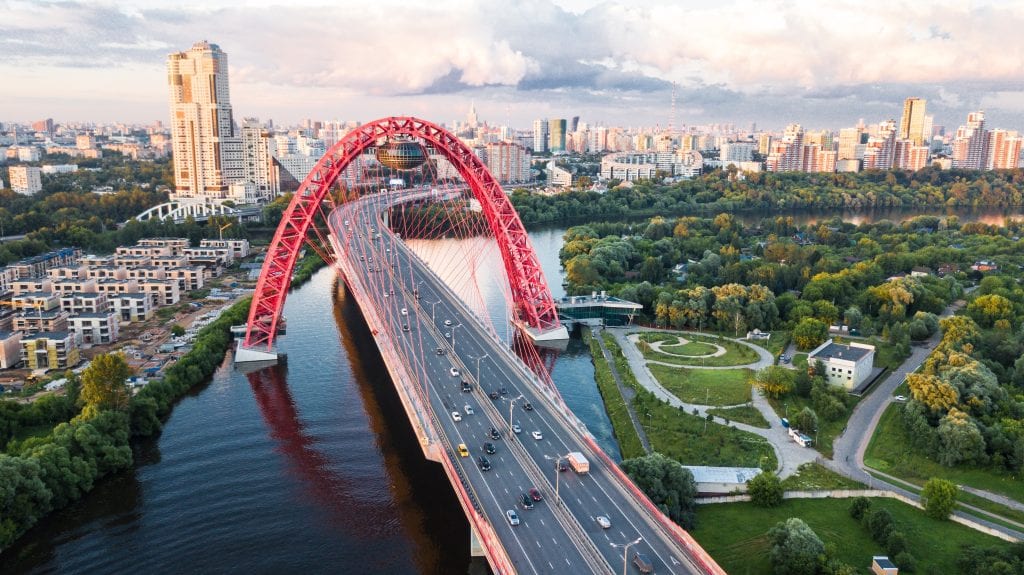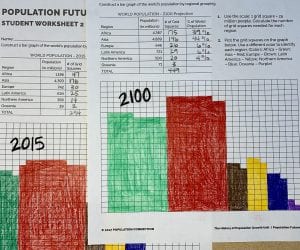Russia has been in the media spotlight a lot lately. Most recently, because they’re hosting this year’s Fifa World Cup. Russia is a massive country that spans 11 time zones and is home to a range of environments from permafrost in Siberia, to volcanoes and earthquakes on the Kamchatka Peninsula. Take our Russia population quiz to learn more!

1. In 2022 Russia’s population was 145.8 million. What is Russia’s population projected to be in 2050?
A. 135.8 million
B. 145.8 million
C. 155.8 million
D. 165.8 million
2. Russia ranks as the largest country in the world by land area.
A. True
B. False
3. As of 2020, Russia’s birth rate was 10/1000, and its death rate was 15/1000. If this continues, and we don’t consider immigration or emigration, what does this mean for Russia’s population?
A. Russia’s population will increase.
B. Russia’s population will decrease.
C. Russia’s population will remain the same.
4. What percent of Russia’s population lives in an urban area?
A. 55%
B. 65%
C. 75%
D. 85%
5. What is the life expectancy for a male in Russia?
A. 56 years
B. 66 years
C. 76 years
D. 86 years
6. What is the life expectancy for a female in Russia?
A. 56 years
B. 66 years
C. 76 years
D. 86 years
7. How many land neighbors does Russia have? In other words, how many countries share a border with Russia?
A. 5 land neighbors
B. 9 land neighbors
C. 12 land neighbors
D. 14 land neighbors
8. Lake Baikal is located in southern Siberia and is the world’s largest freshwater lake (by volume).
A. True
B. False
9. The first artificial Earth satellite was launched by Russia in 1957. What was it called?
A. Skylab
B. Sputnik
C. Kosmos 2251
D. Vanguard 1
10. Which sector accounts for most of Russia’s labor force?
A. Agriculture (such as farming, fishing, and forestry)
B. Industry (such as mining, manufacturing, energy production, and construction)
C. Services (such as government activities, communications, transportation, and finance)
Scroll down for answers!
Answers:
- A – In 2050 Russia’s population is projected to be 135.8 million.
- A – True. Russia is the largest country in the world by land area and is about twice as large as the United States.
- B – Russia’s population will decrease. Note: that this only takes into account the rate of natural increase meaning births versus deaths and not any immigration or emigration.
- C – 75% of Russia’s population resides in urban areas.
- B – The life expectancy for male in Russia is 66 years.
- C – The life expectancy for a female in Russia is 76 years.
- D – Russia has 14 neighboring countries. They are: Azerbaijan, Belarus, China, Estonia, Finland, Georgia, Kazakhstan, North Korea, Latvia, Lithuania, Mongolia, Norway, Poland, and Ukraine.
- A – True. Lake Baikal is the largest freshwater lake in the world by volume. It contains more water than the North American Great Lakes combined.
- B – Russia launched the first ever Earth Satellite called Sputnik.
- C – As of 2019, 67% of Russia’s labor force works in the service sector. Followed by 27% employed in the industry sector and 6% employed in the agriculture sector.
Image credits: Moscow, Russia by Alexander Smagin on Unsplash
Updated May 2022
References
Question 1:
Russia population 2022. Russia Demographics, Maps, Graphs. (n.d.). Retrieved May 10, 2022, from https://worldpopulationreview.com/countries/russia-population
Question 2:
Russia – A Country Profile. Nations Online Project. (n.d.). Retrieved May 10, 2022, from https://www.nationsonline.org/oneworld/russia.htm
Question 3:
United Nations Population Division. (n.d.). Birth rate, crude (per 1,000 people) – Russian Federation. World Bank. Retrieved May 10, 2022, from https://data.worldbank.org/indicator/SP.DYN.CBRT.IN?locations=RU
United Nations Population Division. (n.d.). Death rate, crude (per 1,000 people) – Russian Federation. World Bank. Retrieved May 10, 2022, from https://data.worldbank.org/indicator/SP.DYN.CDRT.IN?locations=RU
Question 4:
United Nations Population Division. (n.d.). Urban population (% of total population) – Russian Federation. World Bank. Retrieved May 10, 2022, from https://data.worldbank.org/indicator/SP.URB.TOTL.IN.ZS?locations=RU
Question 5:
United Nations Population Division. (n.d.). Life expectancy at birth, male (years) – Russian Federation. World Bank. Retrieved May 10, 2022, from https://data.worldbank.org/indicator/SP.DYN.LE00.MA.IN?locations=RU
Question 6:
United Nations Population Division. (n.d.). Life expectancy at birth, female (years) – Russian Federation. World Bank. Retrieved May 10, 2022, from https://data.worldbank.org/indicator/SP.DYN.LE00.FE.IN?locations=RU
Question 7:
Russia – A Country Profile. Nations Online Project. (n.d.). Retrieved May 10, 2022, from https://www.nationsonline.org/oneworld/russia.htm
Question 8:
Lake Baikal, Russia. World Wildlife Fund. (n.d.). Retrieved May 10, 2022, from https://wwf.panda.org/discover/knowledge_hub/where_we_work/lake_baikal/
Question 9:
Sputnik and the Dawn of the Space Age. NASA History Division. (n.d.). Retrieved May 10, 2022, from https://history.nasa.gov/sputnik.html
Question 10:
International Labour Organization. (n.d.). Employment in services (% of total employment) (modeled ILO estimate)- Russian Federation. World Bank. Retrieved May 10, 2022, from https://data.worldbank.org/indicator/SL.SRV.EMPL.ZS?locations=RU
International Labour Organization. (n.d.). Employment in agriculture (% of total employment) (modeled ILO estimate)- Russian Federation. World Bank. Retrieved May 10, 2022, from https://data.worldbank.org/indicator/SL.AGR.EMPL.ZS?locations=RU
International Labour Organization. (n.d.). Employment in industry (% of total employment) (modeled ILO estimate)- Russian Federation. World Bank. Retrieved May 10, 2022, from https://data.worldbank.org/indicator/SL.IND.EMPL.ZS?locations=RU



